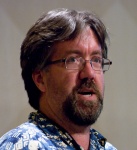Henry Chadwick Award: Mark Armour
This article was written by Rob Neyer
This article was published in Spring 2014 Baseball Research Journal
 Before Mark Armour knew anything about baseball, he fell in love with those little rectangular bits of cardboard with a cheesy photo on the front and those wonderful rows of numbers on the back. He was just five or six years old, and had to ask his dad who Willie Mays was.
Before Mark Armour knew anything about baseball, he fell in love with those little rectangular bits of cardboard with a cheesy photo on the front and those wonderful rows of numbers on the back. He was just five or six years old, and had to ask his dad who Willie Mays was.
In 1960, Mark was born in California an Air Force brat, but moved with his family to New England when he was still a baby. Though he started following the Red Sox in 1967, their Impossible Dream season, he didn’t become obsessed until ’68. And by the time Mark made his first visit to Fenway Park in 1969, he knew everybody on the Red Sox and everybody on the other team—the Yankees, by the way—and upon first seeing the diamond, he was filled with “goosebumps and tingles.” Mark’s favorite player was Carl Yastrzemski, “which is sort of boring,” he says, “but I have to be honest. I used to imitate his batting stance in front of a plate-glass window.”
Mark turned 15 during Game Five of the 1975 World Series. Not long after, he wrote an essay for his English class, “some boring story about my dog or something.” Mark’s teacher gave him a wonderful piece of advice: “Write about something you care about.” So Mark’s next essay was about the World Series, and he has been writing about baseball ever since.
In 1978, Mark went off to college at Rensselaer Polytechnic Institute in Troy, New York. After graduating in 1982 with an engineering degree, he went back to New England and, over the next 11 years, saw 20-odd Red Sox games at Fenway Park per year. Also in 1982, Mark joined SABR after seeing a note about the organization in The Bill James Baseball Abstract. When he joined, Mark received a signed letter from Cliff Kachline. “I was already nerdy enough,” Mark says, “to know who that was, but I didn’t know a single person who would be impressed.” Mark attended his first national convention in 1984 and his second in ’89. The 2013 convention in Philadelphia was his twentieth.
When SABR got involved with the Internet, Mark began to really get involved with SABR. With e-mail and SABR-L facilitating communication among members, Mark began attending conventions regularly, and his first published article was about franchise and league continuity, in the 2000 Baseball Research Journal. Since then he has published many articles in various SABR publications, roughly one every couple of years. In 2003 and 2004, Mark served as head of SABR’s Northwest Chapter, and has twice served as vice president.
And then there’s the BioProject. With SABR ramping up its website in the early aughts, Mark was inspired by Retrosheet and by SABR’s anthology of profiles of Deadball Era Stars, edited by Tom Simon. Why not (Mark thought) use Simon’s template for a much larger project: biographies of every person ever connected with organized baseball? “I was somewhat surprised,” he says, “when people said, ‘Yeah, you should do that.’”
Of course the rest is history, both literally and literally. At this writing (early March 2014) Mark has written and published more than 60 biographical articles for the BioProject, along with articles about other subjects, including integration of Major League Baseball, the seminal book Ball Four, and — as part of another sub-project — that first game Mark attended at Fenway Park back in 1969.
But as Mark says, “My most important contribution to the BioProject, aside from having the idea, is fairly boring, in that what I created was a process, and that process is what has served us so well. Everyone has a small part, and something big has come out of that. Once we actually had material that people could see, a surprising number of people volunteered to write biographies, and our editors have been extraordinary.” Indeed, Armour’s 60-some articles pale next to the total: At press time, nearly 2,700 articles had been published under the BioProject’s rubric.
Mark had moved to Oregon in 1993. One day he was talking to a friend of a friend who said, “Did you know there’s a woman in town whose father pitched for the Indians in 1915?” Mark was skeptical — if people know you’re a baseball aficionado, you’ll hear these stories every so often — but he followed up, and discovered that the daughter of Oscar Harstad, who really had pitched for the Indians for one season, lived only four blocks away. Arrangements were made, and Mark arrived one afternoon to discover that Harstad’s now-elderly daughter not only had a collection of clippings and scrapbooks, but also had interviewed her father late in his life. Armed with all these materials, Mark penned a detailed biographical article that Oscar’s daughter was then delighted to read and share with her extended family.
All of which goes a long way toward explaining what makes the BioProject such a beautiful thing.
Mark received SABR’s Bob Davids Award in 2008, and he has written two books: Paths to Glory with co-author Dan Levitt and Joe Cronin: A Life in Baseball, which was a finalist for SABR’s Seymour Medal in 2011. Today, Mark lives in Corvallis, Oregon, with his wife, Jane, and children, Maya and Drew. And of course his baseball work continues, most notably a follow-up to Paths to Glory (again with Levitt), due in 2015.
To learn more about the Henry Chadwick Award, click here.


